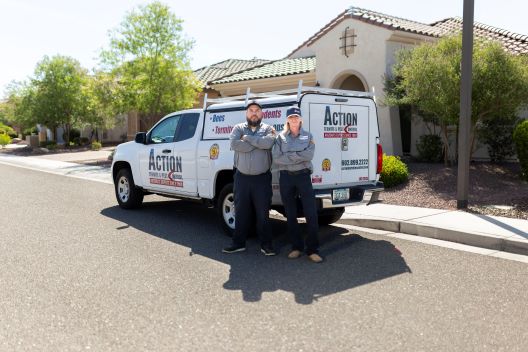How To Fire Pest Control Employees (Professional Approach)

Every pest control business owner reaches the point where they need to fire an employee, whether it’s due to misaligned values, inadequate work performance, or frequent no-call, no-shows. Employee termination is a complex process with much to consider, including:
Fully understanding labor laws to avoid wrongful termination lawsuits or other legal repercussions
Maintaining morale and minimizing disruption to team dynamics
Financial implications of turnover
This guide offers insight into the legal, ethical, and practical aspects of terminating pest control employees.
Before Deciding to Fire an Employee
Take the following steps to ensure you follow company policy and employment regulations before firing an employee.
Gather relevant employee documentation
First, compile any employee documentation that supports your reason for termination. For performance issues, this includes performance reviews, disciplinary records, and attendance logs.
For policy violations, it helps to show documented proof, like a written warning or write-up and a copy of the employee handbook they signed during onboarding to acknowledge they received and reviewed company policies.
Even though most states follow an at-will employment policy, meaning either the employee or employer can terminate the employment relationship for any reason, a company can still be sued for wrongful termination. Documentation helps businesses dispute these claims.
Review policies and consult HR
Thoroughly review your company handbook, code of conduct, and termination procedures to determine if the employee's actions warrant termination. Consult your company’s human resources manager to discuss the matter.
In addition, review your state’s labor laws, which dictate factors like notice periods, severance pay, and acceptable reasons for termination. If the termination could be contentious, seek legal advice to ensure compliance and mitigate potential risks.
Assess performance and impact
Use performance evaluations, client feedback, and productivity metrics to objectively assess employee performance. This helps to uncover:
Documented areas for improvement
Customer service skills
Efficiency and effectiveness
In addition, consider the impact of the termination on your entire team. Identify any potential gaps in skills or knowledge that may arise from the termination and develop a plan to address them.
Determine how to distribute the workload among remaining team members after the termination. Consider redistributing tasks or hiring additional staff if necessary to maintain productivity and service quality.
Consider alternatives to termination
Explore alternatives to termination, such as:
Performance improvement plan: Employers should support struggling employees but set performance boundaries. A performance improvement plan clearly outlines expectations, goals, and timelines for improvement.
Additional training: As part of a performance improvement plan, offer your employee additional training opportunities, whether with a company mentor or through a course hosted by a pest control industry organization.
Reassignment to a new role: If an employee demonstrates a good attitude and makes an effort, consider reassigning them to a role that better aligns with their skills.
Exploring termination alternatives shows a commitment to employee development, which improves company morale and retention.
Document discussions and risk
Keep detailed records of performance discussions, disciplinary actions, and any other relevant communications with the employee. Document each discussion's date, time, participants, and content, including specific performance issues, expectations, and any agreements reached.
Ensure the documentation accurately reflects the discussions and actions taken. Use objective language and provide specific examples of performance issues and their impact on the business.
Assess the potential risks associated with the termination, including legal challenges, impact on team dynamics, and reputational harm. Develop strategies to mitigate these risks, such as providing support to the remaining team members, communicating the decision to stakeholders effectively, and quickly hiring new employees.
Hold pre-termination meeting (optional)
While definitely optional, holding a pre-termination meeting demonstrates a commitment to fairness and transparency in the firing process. It ensures the employee understands the reasons for the potential termination and gives them an opportunity to respond.
Pest control managers use the pre-termination meeting as a last-chance opportunity for employees to improve their performance or behavior before termination.
If employee issues remain unresolved after the pre-termination meeting, begin the termination process.
How to Fire Employees for Pest Control
The following steps outline the process for firing a pest control employee.
1. Prepare for the meeting
Termination meeting preparation includes:
Gather documentation: Collect all relevant documents related to the employee's performance issues, including performance reviews, improvement plans, written warning notifications, the employment contract, and customer complaints.
Choose a time and place: Secure a quiet, confidential space to minimize distractions and provide the employee with privacy. Schedule the meeting for the end of the day when fewer people are around.
Rehearse key points: Rehearse what to say during the meeting. Anticipate the employee’s potential questions and prepare clear, concise responses.
2. Have a witness present (optional)
A witness provides support and objectivity to the termination process. While not always necessary, a witness proves beneficial when there are concerns about how the meeting will be perceived.
When choosing a witness, select an HR representative or another manager who is familiar with the situation but not directly involved in the termination decision. The witness needs to remain objective.
Some employees may feel intimidated or embarrassed when another party is present. If you don’t expect conflict in the meeting, kick it off by asking the employee if they want a witness present. If they say no, it’s OK to conduct the meeting one-on-one.
3. Prepare a concise script
Knowing what you intend to say ahead of time helps you remain calm and professional in person when firing an employee. Prepare a concise script and answers to questions you anticipate the employee asking.
Include the following key points:
Reasons for termination
Next steps (last paycheck date, how to return company property, etc.)
Available support resources (COBRA, employee assistance programs, etc.)
Be prepared to adapt the script based on the employee's reactions and questions, showing empathy and understanding while remaining firm in the decision.
4. Communicate clearly
Use plain, straightforward language to avoid any misinterpretation. Communicate that the decision is final, but offer support and assistance in the transition process.
Maintain professionalism while showing empathy and sensitivity toward the employee's feelings. Acknowledge the difficult situation and express your understanding of the impact it may have on them.
5. Provide specific reasons
Explain the reasons for the termination and provide specific examples to support your decision. Refer back to any documented performance issues, behavioral concerns, and performance improvement plans. This documentation serves as evidence supporting the decision, making it more objective and legally defensible.
Encourage the employee to ask questions or seek clarification about the reasons for their termination. Be prepared to provide detailed explanations and address any concerns.
6. Listen to the response
A termination meeting also serves as an exit interview. Give the employee a chance to share their perspective, including how the company or management can better support employees. Remain open to feedback.
Avoid arguing or becoming defensive, as this only escalates the situation. Respond with empathy and respect by validating the employee’s feelings and thanking them for their positive or negative feedback.
While you should remain firm in your decision, active listening allows the employee to walk away feeling heard and helps you discover opportunities for company improvement.
7. Discuss next steps
Discuss the next steps in detail. Outline the timeline for the employee's departure, including their last day of work. Be clear about whether their termination is effective immediately or if they’re expected to continue working for a set period.
For immediate termination, provide a time for the employee to return to clean out their work area to take home any personal belongings. Arrange for this during non-working hours to avoid onlookers. Instruct employees to bring back any company property at this time.
Other discussion points include:
Final pay and benefits: Explain how and when the terminated employee will receive their final paycheck and whether it will include compensation for accrued vacation or sick leave. Provide information on when benefit coverage ends and how they can continue coverage if applicable.
Support resources: Inform the former employee about any support resources available to them, including employee assistance programs, career counseling services, or access to job placement resources.
Legal considerations: Discuss any legal considerations related to the termination, such as non-disclosure agreements, non-compete clauses, severance packages, and unemployment benefits.
8. Follow up in writing
Draft a written confirmation of the termination meeting, including:
Date of termination
Summary of the discussion
Reasons for termination
Agreed-upon next steps
Include any additional details discussed during the meeting, such as information about severance packages, non-compete agreements, or references. Write and send the termination letter promptly to ensure transparency and facilitate a smooth transition.
Learn More About Growing a Successful Pest Control Business
Firing and hiring employees comes with the territory of a business owner. Successful owners follow a professional process to minimize company disruption.
Reporting features within field service software platforms uncover trends in technician attendance and performance, allowing managers to use the data for termination documentation if needed. For example, the FieldRoutes Operations Dashboard provides a Technicians Rating widget that shows trends in customer ratings.
Check out the FieldRoutes Resource Hub for more information on growing your pest control company, including how to attract and hire the best employees.
Frequently Asked Questions (FAQs)
Still have questions about the termination process? Read on.
Q1. What is the proper procedure for terminating a pest control employee in compliance with labor laws?
The proper procedure for terminating a pest control employee in compliance with labor laws involves documenting performance issues, providing a clear reason for termination, and offering any entitled benefits, such as final pay and unused vacation time. Follow company policies and state labor laws to ensure a fair and legal termination process.
Q2. What is the correct procedure for terminating a pest control employee for poor performance?
The correct procedure for terminating a pest control employee for poor performance includes documenting issues, meeting with the employee to discuss concerns, and providing opportunities for improvement. If performance fails to improve, follow company policies and state labor laws to conduct a fair and transparent termination process.





